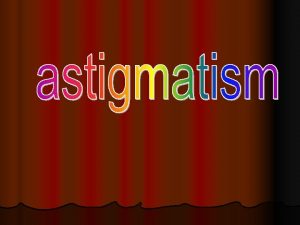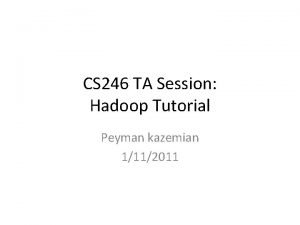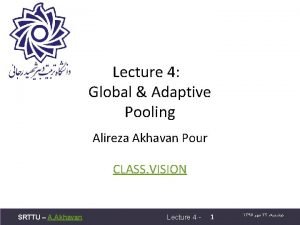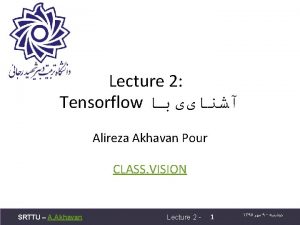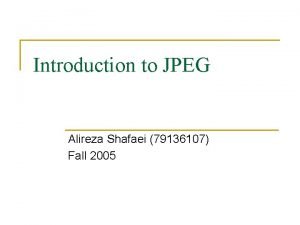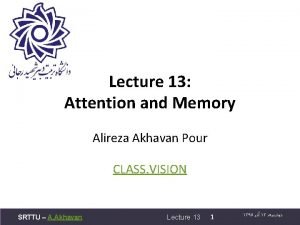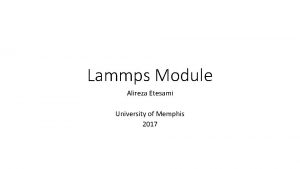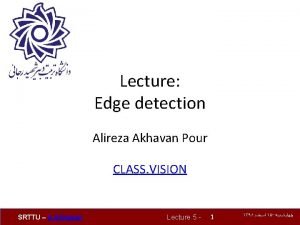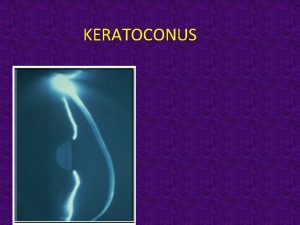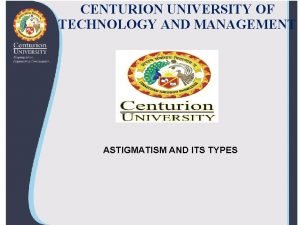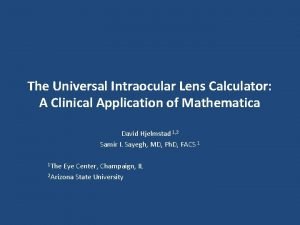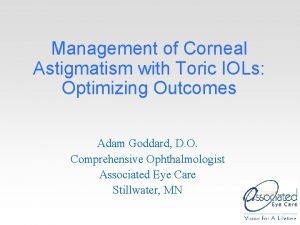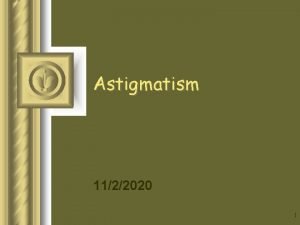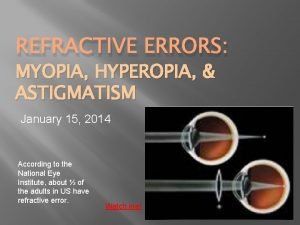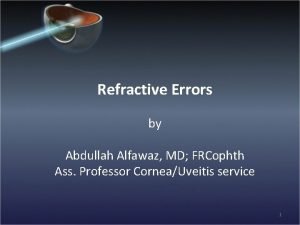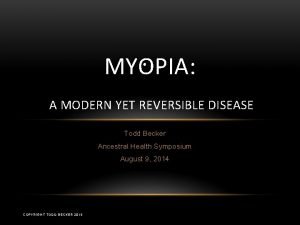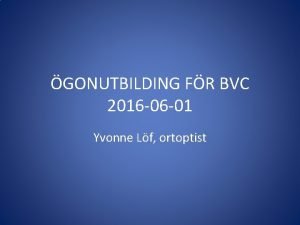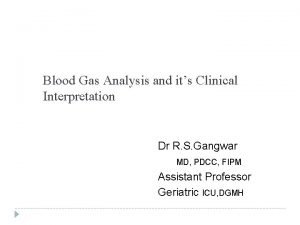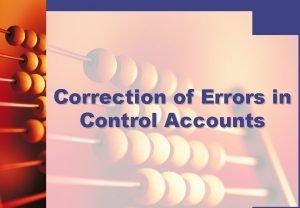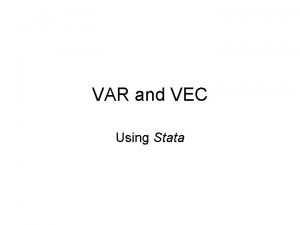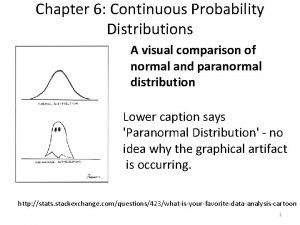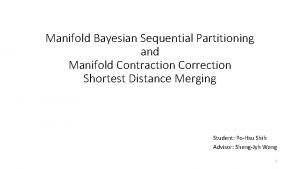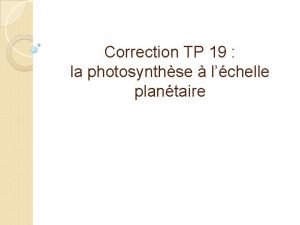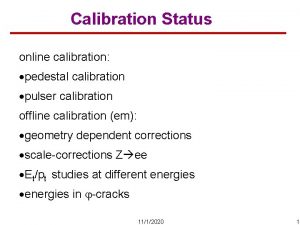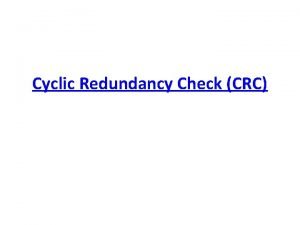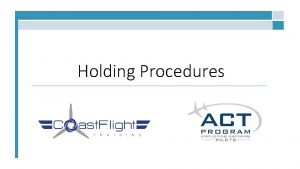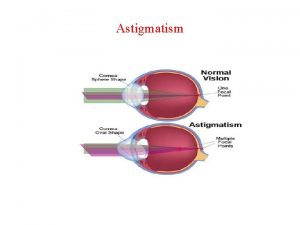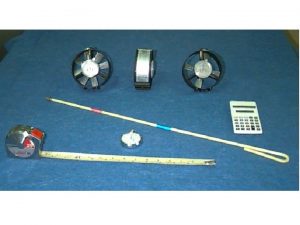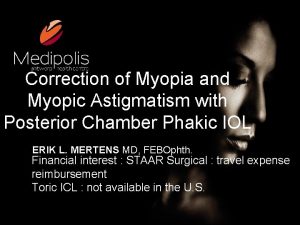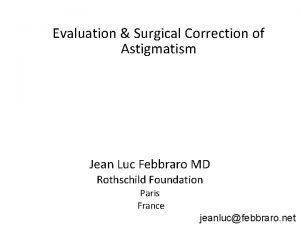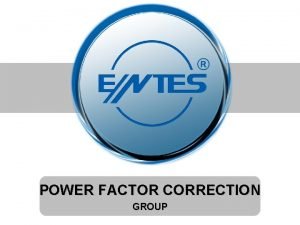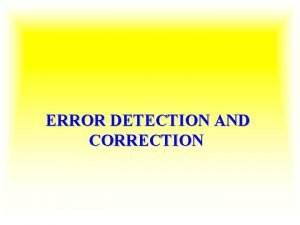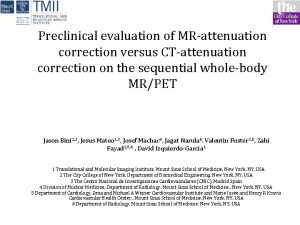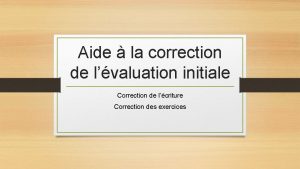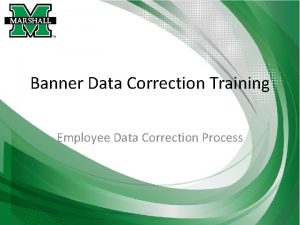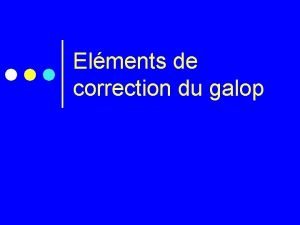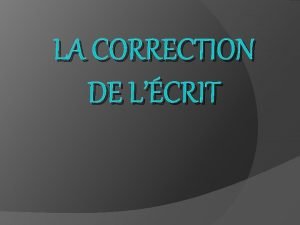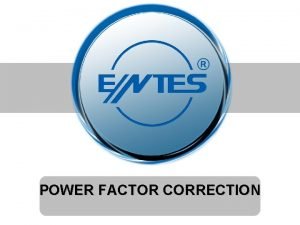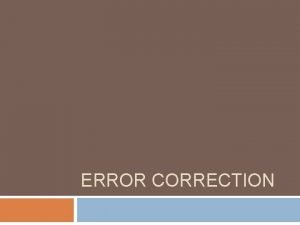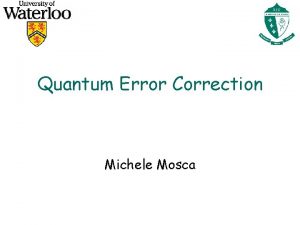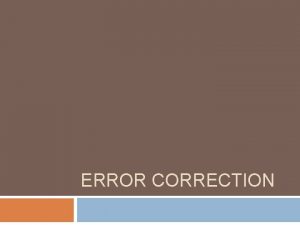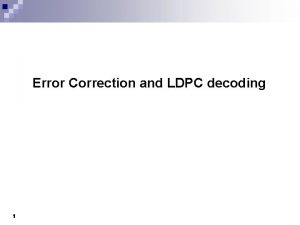Astigmatism correction methods Alireza Peyman MD http www












































- Slides: 44

Astigmatism correction methods Alireza Peyman, MD http: //www. drpeyman. ir

• One of the troublesome aspects of refractive surgery

What is astigmatism • Regular • Irregular

Regular astigmatism

Presbyopic with the rule in near vision

Source of astigmatism • Cornea-tear film • Crystalline lens • Including tilt • Posterior segment

Measurement of astigmatism • Auto-refraction and retinoscopy • Subjective refraction • Astigmatic dial • Cross cylinder • Wavefront PPR • Keratometry • Automated or manual • ORA could be calculated

Correction methods • Glasses • Contacts • Soft (toric) • RGP • orthokeratology • Incisional methods • Traditional • FS assisted • full thickness paired incisions • • Intra-corneal inlays Excimer ablation Toric p. IOLs Toric IOLs

Glasses • Easy and difficult! • Cause distortion of images and depth due to dissimilar meridional magnification in eyes

Easy cases • Persons that have had astigmatic glasses for years or from childhood • Minor vertical or horizontal astigmats • Monocular patients, and children

Most difficult ones • New glasses with > 2. 5 diopters of oblique astigmatism and enantiomorphism • Impaired proprioception (diabetics in some stages)

Contact lens • Always worth try in difficult cases • Irreplaceable for irregular astigmatism

Incisional methods • AK • Arcuate • Straight • LRI • Induced wound dehiscence • After PKP or improperly sutured wounds • Compression sutures & wedge resection • Paired full 3. 2 incision • FS assisted

• Incisional methods mostly used during or after a major intra-ocular surgery like cataract extraction or PKP

Corneal inlays • ICRS • Intra-corneal lenses

Excimer ablation • Case selection • R/O lens problems • Lens tilt or subluxation • Lenticonus • R/O KC

Evaluations • Inquiry about recent refractive change and FHx of KC are important • Check both Placido based topographies and elevations • In Pentacam check • • 4 map Front & Back elevations in detail Belin enhaced ectasia map Refractive map for KC indices



Toric ellipsoid fixed reference body



• Use front and back Pentacam elevation maps with “toric ellipsoid fixed” reference if you have decided to proceed to surgery.

Measurements • Always look at autorefraction • Check subjective refraction and BCVA • Consider keratometric astigmatism • Amount • Axis • Check PPR and optical aberrations

• Decide for the amount and axis of the correction seeing all measurements • Under-correct the power for at least 5% to decrease induced astigmatism due to angle of error of corrections. • Check, check, and recheck the numbers at each stage.

Determine ablation protocol • Conventional (Plano-scan) • Tissue Saving • Aspheric • Customized WF guided

WF guided ablation (APT) • Best for moderately aberrated corneas • Not suitable for highly aberrated eyes • Removes much higher amount of tissue • Post-op hyperopia may arise • Not appropriate for patients with non-corneal aberrations • Crystalline lens opacities • Cloudiness of vitreous • No benefit in eyes with low aberration

Errors of angle of correction • Exact alignment of measured angle of astigmatism with angle of correction is of paramount importance for best results in astigmatic correction.

Basis of error in angle alignment • Position of head and eyes are different in upright measurement phase and supine correction stage. • Incorrect position of head compared to body in operation cradle. • Misaligned and unlucked operating bed.




Only 5 degrees of tilt make difference


Head tilt in upright position

• This type of rotation does not occur in supine position. • This phenomenon cause error even if the amount of tilt were similar in upright and supine positions

Rotational registration • Manual • Mark 90, 180, and 270 in upright • Re-align with axes in operating bed • Automated • Iris image registration

Automated Iris registration • Takes iris image in sitting position • Takes another image immediately before Sx and compensate rotation comparing two images

Iris registration tips • Add another image taken in exam room with room lights on • Turn off lights in OR • Align with pupil center exactly • Don’t move head until beginning of ablation

Tips (cont. ) • If registration unsuccessful: • Turn off all lights even of monitor and red green target lights • Use both of two LED IR light sources • I prefer to remove epithelium before registration for quick continuing of the surgery.

Toric p. IOLs & IOLs • Available options: • • • Toric phakic artisan Toric Artiflex Toric ICL Toric IOLs of multiple brands Toric supplement IOLs for sulcus

Drawbacks • Cost • Availability • Imaginable complications with intra-ocular surgery • Problems with stability of lens

• Occasionally Difficult pre-op marking • Sometimes difficult intra-operative alignment

 Www.drpeyman.ir
Www.drpeyman.ir Ctk lasik
Ctk lasik Alireza yalda
Alireza yalda Oblique astigmatism definition
Oblique astigmatism definition Peyman milanfar
Peyman milanfar Peyman kazemian
Peyman kazemian Pgnna
Pgnna Dr. alireza amirbaigloo, md, endocrinologist
Dr. alireza amirbaigloo, md, endocrinologist Alireza khosravi
Alireza khosravi Alireza ahadi
Alireza ahadi Adaptive max pooling
Adaptive max pooling Alireza yalda
Alireza yalda Tf 2
Tf 2 Alireza shafaei
Alireza shafaei Alireza akhavanpour
Alireza akhavanpour Alireza yalda
Alireza yalda Dr. alireza amirbaigloo, md, endocrinologist
Dr. alireza amirbaigloo, md, endocrinologist Alireza etesami
Alireza etesami Alireza firooz
Alireza firooz Alireza akhavanpour
Alireza akhavanpour Alireza farshi
Alireza farshi Metal coping fpd
Metal coping fpd Oil droplet sign
Oil droplet sign Bi oblique astigmatism
Bi oblique astigmatism Astigmatism fix calculator
Astigmatism fix calculator Acrysoftoriccalculator
Acrysoftoriccalculator With the rule astigmatism axis
With the rule astigmatism axis Astigmatism
Astigmatism Ass
Ass Astigmatisml
Astigmatisml Active focusing myopia
Active focusing myopia Inåtskelning
Inåtskelning Siat.ung.ac.id
Siat.ung.ac.id Http //mbs.meb.gov.tr/ http //www.alantercihleri.com
Http //mbs.meb.gov.tr/ http //www.alantercihleri.com Kinetic energy of a fluid
Kinetic energy of a fluid Urine anion gap calculator
Urine anion gap calculator Correction of errors in accounting questions
Correction of errors in accounting questions Var model
Var model Continuity correction
Continuity correction Rolling shutter correction
Rolling shutter correction Correction
Correction Photosynthèse à l'échelle planétaire corrigé
Photosynthèse à l'échelle planétaire corrigé Nlc calibration
Nlc calibration Concept of redundancy in error detection and correction
Concept of redundancy in error detection and correction Hold procedure meaning
Hold procedure meaning



